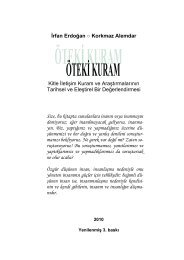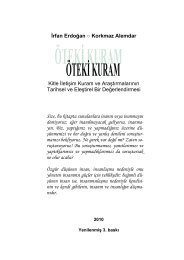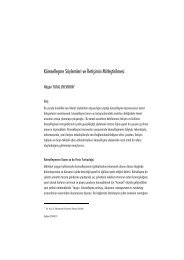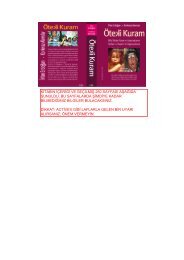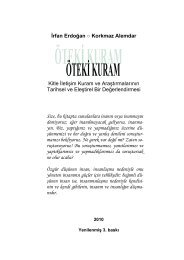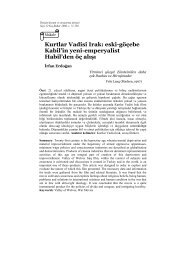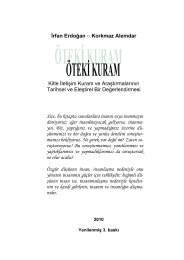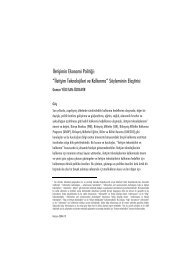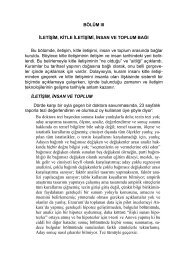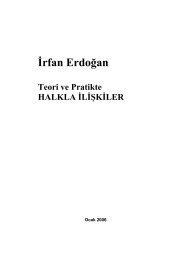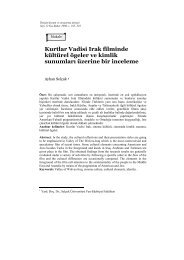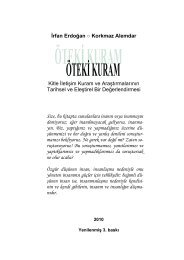From news-gathering to news- making: a flood of pseudo-events
From news-gathering to news- making: a flood of pseudo-events
From news-gathering to news- making: a flood of pseudo-events
- No tags were found...
Create successful ePaper yourself
Turn your PDF publications into a flip-book with our unique Google optimized e-Paper software.
İletişim kuram ve araştırma dergisiSayı 24 Kış-Bahar 2007, s. 251-270Forum<strong>From</strong> <strong>news</strong>-<strong>gathering</strong> <strong>to</strong> <strong>news</strong><strong>making</strong>:a <strong>flood</strong> <strong>of</strong> <strong>pseudo</strong>-<strong>events</strong>Daniel J. Boorstin 1Her akşam izlediğimiz haberlerin (eğer izliyorsak, çünkü insanlar giderekhaber denen şeyleri de izlememeye başladı) hemen herkes artık ne kadarınınhaber olduğu hakkında ciddi şüpheye sahip. Televizyon haberleri haberdençok promosyon ve halkla ilişkilerden başlayarak gizli reklama kadarçeşitlenen “haber olmayan haberler” ile doldurulmaktadır. Bu tür haberlertelevizyondan önce 19. ve 20. yüzyılda gazetelerde kurnazca kullanılıyordu.Televizyonla birlikte bu tür amaç için televizyonda işlevsel bir araç olmuştur.Bu kullanım günümüzde “haber denen şeylerin çok azının haber olduğudüşüncesini yaygınlaştıran bir duruma geldi. Boorstin 1960’ın IMAGE adlıkitabında başında bu durumu çok açık bir şekilde irdelemektedir: Boorstinhaber medyasının sahte olaylar hazırladığını, çünkü insanların haberlerdeheyecan aradığını, bu arayışta ona sunulanlara kanmadığı, sadece heyecanıyaşadığını, fakat aynı zamanda “haberle bilgilendirilmediği” (enformasyonalmadığı) üzerinde durur. Bu bağlamda, Boorstin’in kitabından sahte olaydüzenlemeyle ilgili alıntılar sunuldu. Bu sunumda, diğer sunumlarda daolduğu gibi, hem sunanın kuramsal yaklaşımı (dolayısıyla, dünya görüşü) hemde açıklamaların medya ve yansıttığı dünyamızı anlamamız için ipuçlarıaramamız ve eleştirel bir şekilde sunulanı irdelememiz gerekir.1 Orijinal kaynak: Daniel J. Boorstin (1961) The Image: A Guide <strong>to</strong> Pseudo-Events inAmerica. NewYork: Harper Colophon.Kaynak: Schramm, W. ve Roberts, D. F. (1971) The Process and Effects <strong>of</strong> MassCommunication. Urbana: University <strong>of</strong> Illinois Press, s. 116-150.
252D. BoorstinADMIRING FRIEND:"My, that's a beautiful baby you have there!"MOTHER:"Oh, that's nothing—you should see his pho<strong>to</strong>graph!"IThe simplest <strong>of</strong> our extravagant expectations concerns the amount <strong>of</strong>novelty in the world. There was a time when the reader <strong>of</strong> an unexciting<strong>news</strong>paper would remark, "How dull is the world <strong>to</strong>day!" Nowadays he says,"What a dull <strong>news</strong>paper!" When the first American <strong>news</strong>paper, BenjaminHarris's Public Occurrences Both Foreign and Domestic, appeared in Bos<strong>to</strong>non September 25, 1690, it promised <strong>to</strong> furnish <strong>news</strong> regularly once a month.But, the edi<strong>to</strong>r explained, it might appear <strong>of</strong>tener "if any Glut <strong>of</strong> Occurrenceshappen." The responsibility for <strong>making</strong> <strong>news</strong> was entirely God's—or theDevil's. The <strong>news</strong>man's task was only <strong>to</strong> give "an Account <strong>of</strong> such considerablethings as have arrived un<strong>to</strong> our Notice" (p. 116). Although the theologybehind this way <strong>of</strong> looking at <strong>events</strong> soon dissolved, this view <strong>of</strong> the <strong>news</strong>lasted longer. "The skilled and faithful journalist," James Par<strong>to</strong>n observed in1866, "recording with exactness and power the thing that has come <strong>to</strong> pass, isProvidence addressing men." The s<strong>to</strong>ry is <strong>to</strong>ld <strong>of</strong> a Southern Baptistclergyman before the Civil War who used <strong>to</strong> say, when a <strong>news</strong>paper wasbrought in the room, "Be kind enough <strong>to</strong> let me have it a few minutes, till Isee how the Supreme Being is governing the world." Charles A. Dana, one <strong>of</strong>the great American edi<strong>to</strong>rs <strong>of</strong> the nineteenth century, once defended hisextensive reporting <strong>of</strong> crime in the New York Sun by saying, "I have alwaysfelt that whatever the Divine Providence permitted <strong>to</strong> occur I was not <strong>to</strong>oproud <strong>to</strong> report."Of course, this is now a very old-fashioned way <strong>of</strong> thinking. Our currentpoint <strong>of</strong> view is better expressed in the definition by Arthur MacEwen, whomWilliam Randolph Hearst made his first edi<strong>to</strong>r <strong>of</strong> the San Francisco Examiner:"News is anything that makes a reader say, 'Gee whiz!' " Or, put more soberly,"News is whatever a good edi<strong>to</strong>r chooses <strong>to</strong> print."We need not be theologians <strong>to</strong> see that we have shifted responsibility for<strong>making</strong> the world interesting from God <strong>to</strong> the <strong>news</strong>paperman. We used <strong>to</strong>believe there were only so many "<strong>events</strong>" in the world. If there were not manyintriguing or startling occurrences, it was no fault <strong>of</strong> the reporter. He could notbe expected <strong>to</strong> report what did not exist.
Flood <strong>of</strong> <strong>pseudo</strong>-<strong>events</strong> 253Within the last hundred years, however, and especially in the twentiethcentury, all this has changed. We expect the papers <strong>to</strong> be full <strong>of</strong> <strong>news</strong>. If thereis no <strong>news</strong> visible <strong>to</strong> the naked eye, or <strong>to</strong> the average citizen, we still expect it<strong>to</strong> be there for the enterprising <strong>news</strong>man. The successful reporter is one whocan find a s<strong>to</strong>ry, even if there is no earthquake or assassination or civil war. Ifhe cannot find a s<strong>to</strong>ry, then he must make one —by the questions he asks <strong>of</strong>public figures, by the surprising human interest he unfolds from somecommonplace event, or by "the <strong>news</strong> behind the <strong>news</strong>." If all this fails, thenhe must give us a "think piece"—an embroidering <strong>of</strong> well-known facts, or aspeculation about startling things <strong>to</strong> come.This change in our attitude <strong>to</strong>ward "<strong>news</strong>" is not merely a basic fact aboutthe his<strong>to</strong>ry <strong>of</strong> American <strong>news</strong>papers (p. 117). It is a symp<strong>to</strong>m <strong>of</strong> arevolutionary change in our attitude <strong>to</strong>ward what happens in the world, howmuch <strong>of</strong> it is new, and surprising, and important. Toward how life can beenlivened, <strong>to</strong>ward our power and the power <strong>of</strong> those who inform and educateand guide us, <strong>to</strong> provide synthetic happenings <strong>to</strong> make up for the lack <strong>of</strong>spontaneous <strong>events</strong>. Demanding more than the world can give us, we requirethat something be fabricated <strong>to</strong> make up for the world's deficiency. This isonly one example <strong>of</strong> our demand for illusions.Many his<strong>to</strong>rical forces help explain how we have come <strong>to</strong> our presentimmoderate hopes. But there can be no doubt about what we now expect, northat it is immoderate. Every American knows the anticipation with which hepicks up his morning <strong>news</strong>paper at breakfast or opens his evening paper beforedinner, or listens <strong>to</strong> the <strong>news</strong>casts every hour on the hour as he drivesacross country, or watches his favorite commenta<strong>to</strong>r on television interpret the<strong>events</strong> <strong>of</strong> the day. Many enterprising Americans are now at work <strong>to</strong> help ussatisfy these expectations. Many might be put out <strong>of</strong> work if we shouldsuddenly moderate our expectations. But it is we who keep them in businessand demand that they fill our consciousness with novelties, that they play Godfor us.The new kind <strong>of</strong> synthetic novelty which has <strong>flood</strong>ed our experience I willcall "<strong>pseudo</strong>-<strong>events</strong>." The common prefix "<strong>pseudo</strong>" comes from the Greekword meaning false, or intended <strong>to</strong> deceive. Before I recall the his<strong>to</strong>ricalforces which have made these <strong>pseudo</strong>-<strong>events</strong> possible, have increased thesupply <strong>of</strong> them and the demand for them, I will give a commonplace example.The owners <strong>of</strong> a hotel, in an illustration <strong>of</strong>fered by Edward L. Bernays inhis pioneer Crystallizing Public Opinion, consult a public relations counsel.
254D. BoorstinThey ask how <strong>to</strong> increase their hotel's prestige and so improve their business.In less sophisticated times, the answer might have been <strong>to</strong> hire a new chef, <strong>to</strong>improve the plumbing, <strong>to</strong> paint the rooms, or <strong>to</strong> install a crystal chandelier inthe lobby (p. 118). The public relations counsel's technique is more indirect.He proposes that the management stage a celebration <strong>of</strong> the hotel's thirtiethanniversary. A committee is formed, including a prominent banker, a leadingsociety matron, a well-known lawyer, an influential preacher, arid an "event"is planned (say a banquet) <strong>to</strong> call attention <strong>to</strong> the distinguished service thehotel has been rendering the community. The celebration is held, pho<strong>to</strong>graphsare taken, the occasion is widely reported, and the object is accomplished.Now this occasion is a <strong>pseudo</strong>-event, and will illustrate all the essentialfeatures <strong>of</strong> <strong>pseudo</strong>-<strong>events</strong>.This celebration, we can see at the outset, is somewhat—but notentirely—misleading. Presumably the public relations counsel would not havebeen able <strong>to</strong> form his committee <strong>of</strong> prominent citizens if the hotel had notactually been rendering service <strong>to</strong> the community. On the other hand, if thehotel's services had been all that important, instigation by public relationscounsel might not have been necessary. Once the celebration has been held,the celebration itself becomes evidence that the hotel really is a distinguishedinstitution. The occasion actually gives the hotel the prestige <strong>to</strong> which it ispretending.It is obvious, <strong>to</strong>o, that the value <strong>of</strong> such a celebration <strong>to</strong> the ownersdepends on its being pho<strong>to</strong>graphed and reported in <strong>news</strong>papers, magazines,<strong>news</strong>reels, on radio, and over television. It is the report that gives the event itsforce in the minds <strong>of</strong> potential cus<strong>to</strong>mers. The power <strong>to</strong> make a reportableevent is thus the power <strong>to</strong> make experience. One is reminded <strong>of</strong> Napoleon'sapocryphal reply <strong>to</strong> his general, who objected that circumstances wereunfavorable <strong>to</strong> a proposed campaign: "Bah, I make circumstances!" Themodern public relations counsel-arid he is, <strong>of</strong> course, only one <strong>of</strong> manytwentieth-century crea<strong>to</strong>rs <strong>of</strong> <strong>pseudo</strong>-<strong>events</strong>—has come close <strong>to</strong> fulfillingNapoleon's idle boast. "The counsel on public relations," Mr. Bernays explains,"not only knows what <strong>news</strong> value is, but knowing it, he is in a position<strong>to</strong> make <strong>news</strong> happen. He is a crea<strong>to</strong>r <strong>of</strong> <strong>events</strong>."The intriguing feature <strong>of</strong> the modern situation, however, comes preciselyfrom the fact that the modern <strong>news</strong>-makers are not God (p. 119). The <strong>news</strong>they make happen, the <strong>events</strong> they create, are somehow not quite real. Thereremains a tantalizing difference between man-made and God-made <strong>events</strong>.
Flood <strong>of</strong> <strong>pseudo</strong>-<strong>events</strong> 255A <strong>pseudo</strong>-event, then, is a happening that possesses the followingcharacteristics, (1) It is not spontaneous, but comes about because someonehas planned, planted, or incited it. Typically, it is not a train wreck or anearthquake, but an interview. (2) It is planted primarily (not alwaysexclusively) for the immediate purpose <strong>of</strong> being reported or reproduced.Therefore, its occurrence is arranged for the convenience <strong>of</strong> the reporting orreproducing media. Its success is measured by how widely it is reported. Timerelations in it are commonly fictitious or factitious; the announcement is givenout in advance "for future release" and written as if the event had occurred inthe past. The question, "Is it real?" is less important than, "Is it <strong>news</strong>worthy?"(3) Its relation <strong>to</strong> the underlying reality <strong>of</strong> the situation is ambiguous. Itsinterest arises largely from this very ambiguity. Concerning a <strong>pseudo</strong>-eventthe question, "What does it mean?" has a new dimension. While the <strong>news</strong>interest in a train wreck is in what happened and in the real consequences, theinterest in an interview is always, in a sense, in whether it really happened andin what might have been the motives. Did the statement really mean what itsaid? Without some <strong>of</strong> this ambiguity a <strong>pseudo</strong>-event cannot be very interesting.(4) Usually it is intended <strong>to</strong> be a self-fulfilling prophecy. The hotel'sthirtieth-anniversary celebration, by saying that the hotel is a distinguishedinstitution, actually makes it one.IIIn the last half century a larger and larger proportion <strong>of</strong> our experience, <strong>of</strong>what we read and see and hear, has come <strong>to</strong> consist <strong>of</strong> <strong>pseudo</strong>-<strong>events</strong>. Weexpect more <strong>of</strong> them and we are given more <strong>of</strong> them. They <strong>flood</strong> ourconsciousness. Their multiplication has gone on in the United States at afaster rate than elsewhere. Even the rate <strong>of</strong> increase is increasing every day.This is true <strong>of</strong> the world <strong>of</strong> education, <strong>of</strong> consumption, and <strong>of</strong> personalrelations. It is especially true <strong>of</strong> the world <strong>of</strong> public affairs which I describe inthis chapter (p. 120).A full explanation <strong>of</strong> the origin and rise <strong>of</strong> <strong>pseudo</strong>-<strong>events</strong> would benothing less than a his<strong>to</strong>ry <strong>of</strong> modern America. For our present purposes it isenough <strong>to</strong> recall a few <strong>of</strong> the more revolutionary recent developments.The great modern increase in the supply and the demand for <strong>news</strong> beganin the early nineteenth century. Until then <strong>news</strong>papers tended <strong>to</strong> fill out theircolumns with lackadaisical secondhand accounts or stale reprints <strong>of</strong> items firstpublished elsewhere at home and abroad. The laws <strong>of</strong> plagiarism and <strong>of</strong>
256D. Boorstincopyright were undeveloped. Most <strong>news</strong>papers were little more than excusesfor espousing a political position, for listing the arrival and departure <strong>of</strong> ships,for familiar essays and useful advice, or for commercial or legalannouncements.These <strong>events</strong> were part <strong>of</strong> a great, but little-noticed, revolution—what Iwould call the Graphic Revolution. Man's ability <strong>to</strong> make, preserve, transmit,and disseminate precise images—images <strong>of</strong> print, <strong>of</strong> men and landscapes and<strong>events</strong>, <strong>of</strong> the voices <strong>of</strong> men and mobs—now grew at a fantastic pace. Theincreased speed <strong>of</strong> printing was itself revolutionary. Still more revolutionarywere the new techniques for <strong>making</strong> direct images <strong>of</strong> nature (p. 121).The new power <strong>to</strong> report and portray what had happened was a newtemptation leading <strong>news</strong>men <strong>to</strong> make probable images or <strong>to</strong> prepare reports inadvance <strong>of</strong> what was expected <strong>to</strong> happen. As so <strong>of</strong>ten, men came <strong>to</strong> mistaketheir power for their necessities. Readers and viewers would soon prefer thevividness <strong>of</strong> the account, the "candidness" <strong>of</strong> the pho<strong>to</strong>graph, <strong>to</strong> thespontaneity <strong>of</strong> what was recounted.Then came round-the-clock media. The <strong>news</strong> gap soon became so narrowthat in order <strong>to</strong> have additional "<strong>news</strong>" for each new edition or each newbroadcast it was necessary <strong>to</strong> plan in advance the stages by which anyavailable <strong>news</strong> would be unveiled (p. 122). After the weekly and the dailycame the "extras" and the numerous regular editions. The PhiladelphiaEvening Bulletin soon had seven editions a day. No rest for the <strong>news</strong>man.With more space <strong>to</strong> fill, he had <strong>to</strong> fill it ever more quickly. In order <strong>to</strong> justifythe numerous editions, it was increasingly necessary that the <strong>news</strong> constantlychange or at least seem <strong>to</strong> change. With radio on the air continuously duringwaking hours, the reporters' problems became still more acute. News everyhour on the hour, and sometimes on the half hour. Programs interrupted anytime for special bulletins. How <strong>to</strong> avoid deadly repetition, the appearance thatnothing was happening, that <strong>news</strong>-gatherers were asleep, or that competi<strong>to</strong>rswere more alert? As the costs <strong>of</strong> printing and then <strong>of</strong> broadcasting increased,it became financially necessary <strong>to</strong> keep the presses always at work and the TVscreen always busy. Pressures <strong>to</strong>ward the <strong>making</strong> <strong>of</strong> <strong>pseudo</strong>-<strong>events</strong> becameever stronger. News-<strong>gathering</strong> turned in<strong>to</strong> <strong>news</strong>-<strong>making</strong>.The "interview" was a novel way <strong>of</strong> <strong>making</strong> <strong>news</strong> which had come in withthe Graphic Revolution. Later it became elaborated in<strong>to</strong> lengthy radio andtelevision panels and quizzes <strong>of</strong> public figures, and the three-hour-long,rambling conversation programs. Although the interview technique might
Flood <strong>of</strong> <strong>pseudo</strong>-<strong>events</strong> 257seem an obvious one—and in a primitive form was as old as Socrates—theuse <strong>of</strong> the word in its modern journalistic sense is a relatively recentAmericanism. Ellen Jewett, inmate <strong>of</strong> a house <strong>of</strong> prostitution, had been foundmurdered by an ax. Richard P. Robinson, a young man about <strong>to</strong>wn, wasaccused <strong>of</strong> the crime. Bennett seized the occasion <strong>to</strong> pyramid sensationals<strong>to</strong>ries and so <strong>to</strong> build circulation for his Herald; before long he was havingdifficulty turning out enough copies daily <strong>to</strong> satisfy the demand. He exploitedthe s<strong>to</strong>ry in every possible way, one <strong>of</strong> which was <strong>to</strong> plan and report an actualinterview with Rosina Townsend, the madam who kept the house and whomhe visited on her own premises (p. 123).His<strong>to</strong>rians <strong>of</strong> journalism date the first full-fledged modern interview witha well-known public figure from July 13, 1859, when Horace Greeleyinterviewed Brigham Young in Salt Lake City, asking him questions on manymatters <strong>of</strong> public interest, and then publishing the answers verbatim in hisNew York Tribune (August 20, 1859). The common use <strong>of</strong> the word "interview"in this modern American sense first came in about this time. …Afew years later another magazine edi<strong>to</strong>r called the interview "the most perfectcontrivance yet devised <strong>to</strong> make journalism an <strong>of</strong>fence, a thing <strong>of</strong> ill savor inall decent nostrils." Many objected <strong>to</strong> the practice as an invasion <strong>of</strong> privacy.After the American example it was used in England and France, but in boththose countries it made much slower headway.Even before the invention <strong>of</strong> the interview, the <strong>news</strong>-<strong>making</strong> pr<strong>of</strong>ession inAmerica had attained a new dignity as well as a menacing power. It was in1828 that Macaulay called the gallery where reporters sat in Parliament a"fourth estate <strong>of</strong> the realm." But Macaulay could not have imagined theprestige <strong>of</strong> journalists in the twentieth-century United States. They have longsince made themselves the tribunes <strong>of</strong> the people. Their supposed detachmentand lack <strong>of</strong> partisanship, their closeness <strong>to</strong> the sources <strong>of</strong> information, theirarticulateness, and their constant and direct access <strong>to</strong> the whole citizenry havemade them also the counselors <strong>of</strong> the people. Foreign observers are nowas<strong>to</strong>nished by the almost constitutional—perhaps we should saysupraconstitutional—powers <strong>of</strong> our Washing<strong>to</strong>n press corps.Since the rise <strong>of</strong> the modern presidential press conference, about 1933,capital correspondents have had the power regularly <strong>to</strong> question the presidentface-<strong>to</strong>-face, <strong>to</strong> embarrass him, <strong>to</strong> needle him, <strong>to</strong> force him in<strong>to</strong> positions orin<strong>to</strong> public refusal <strong>to</strong> take a position (p. 124). A president may find itinconvenient <strong>to</strong> meet a group <strong>of</strong> dissident sena<strong>to</strong>rs or congressmen; he seldom
258D. Boorstindares refuse the press. That refusal itself becomes <strong>news</strong>. It is only veryrecently, and as a result <strong>of</strong> increasing pressures by <strong>news</strong>men, that the phrase"No comment" has become a way <strong>of</strong> saying something important. Thereputation <strong>of</strong> <strong>news</strong>men—who now <strong>of</strong> course include those working for radio,TV, and magazines —depends on their ability <strong>to</strong> ask hard questions, <strong>to</strong> putpoliticians on the spot; their very livelihood depends on the willingcollaboration <strong>of</strong> public figures. Even before 1950 Washing<strong>to</strong>n had about1,500 correspondents and about 3,000 government information <strong>of</strong>ficialsprepared <strong>to</strong> serve them.The live television broadcasting <strong>of</strong> the president's regular <strong>news</strong>conferences, which President Kennedy began in 1961, immediately aftertaking <strong>of</strong>fice, has somewhat changed their character. Newsmen are no longerso important as intermediaries who relay the president's statements. But thenew occasion acquires a new interest as a dramatic performance. Citizens wh<strong>of</strong>rom homes or <strong>of</strong>fices have seen the president at his <strong>news</strong> conference are theneven more interested <strong>to</strong> hear competing interpretations by skilledcommenta<strong>to</strong>rs. News commenta<strong>to</strong>rs can add a new appeal as dramatic critics<strong>to</strong> their traditional role as interpreters <strong>of</strong> current his<strong>to</strong>ry. Even in the newformat it is still the <strong>news</strong>men who put the questions (p. 125). … WeAmericans have accommodated our eighteenth-century constitution <strong>to</strong>twentieth-century technology by multiplying <strong>pseudo</strong>-<strong>events</strong> and bydeveloping pr<strong>of</strong>essions which both help make <strong>pseudo</strong>-<strong>events</strong> and help usinterpret them. The disproportion between what an informed citizen needs <strong>to</strong>know and what he can know is ever greater. The disproportion grows with theincrease <strong>of</strong> the <strong>of</strong>ficials' powers <strong>of</strong> concealment and contrivance. The <strong>news</strong>gatherers' need <strong>to</strong> select, invent, and plan correspondingly increases. Thusinevitably our whole system <strong>of</strong> public information produces always more"packaged" <strong>news</strong>, more <strong>pseudo</strong>-<strong>events</strong>.The common "<strong>news</strong> releases" which every day issue by the ream fromcongressmen's <strong>of</strong>fices, from the president's press secretary, from the pressrelations <strong>of</strong>fices <strong>of</strong> businesses, charitable organizations, and universities are akind <strong>of</strong> Congressional Record covering all American life (p. 126). And theyare only a slightly less inaccurate record <strong>of</strong> spontaneous happenings. Tosecure "<strong>news</strong> coverage" for an event (especially if it has little <strong>news</strong> interest)one must issue, in proper form, a "release." The very expression "<strong>news</strong>release" (apparently an American invention; it was first recorded in 1907) didnot come in<strong>to</strong> common use until recently. There is an appropriate perversity in
Flood <strong>of</strong> <strong>pseudo</strong>-<strong>events</strong> 259calling it a "release." It might more accurately be described as a "<strong>news</strong>holdback," since its purpose is <strong>to</strong> <strong>of</strong>fer something that is <strong>to</strong> be held back frompublication until a specified future date. The <strong>news</strong>paperman's slightlyderoga<strong>to</strong>ry slang term for the <strong>news</strong> release is "handout," from the phraseoriginally used for a bundle <strong>of</strong> stale food handed out from a house <strong>to</strong> a beggar.Though this meaning <strong>of</strong> the word is now in common use in the <strong>news</strong>-<strong>gathering</strong>pr<strong>of</strong>essions, it is so recent that it has not yet made its way in<strong>to</strong> ourdictionaries.The release is <strong>news</strong> precooked, and supposed <strong>to</strong> keep till needed. In thewell-recognized format (usually mimeographed) it bears a date, say Februaryi, and also indicates, "For release <strong>to</strong> p.m.'s February 15." The account iswritten in the past tense but usually describes an event that has not yethappened when the release is given out. The use and interpretation <strong>of</strong> handoutshave become an essential part <strong>of</strong> the <strong>news</strong>man's job. …In 1947 therewere about twice as many government press agents engaged in preparing<strong>news</strong> releases as there were <strong>news</strong>men <strong>gathering</strong> them in.The general public has become so accus<strong>to</strong>med <strong>to</strong> these procedures that apublic <strong>of</strong>ficial can sometimes "make <strong>news</strong>" merely by departing from theadvance text given out in his release (p. 127).We begin <strong>to</strong> be puzzled about what is really the "original" <strong>of</strong> an event.The authentic <strong>news</strong> record <strong>of</strong> what "happens" or is said comes increasingly <strong>to</strong>seem <strong>to</strong> be what is given out in advance. More and more <strong>news</strong> <strong>events</strong> becomedramatic performances in which "men in the <strong>news</strong>" simply act out more orless well their prepared script. The s<strong>to</strong>ry prepared "for future release" acquiresan authenticity that competes with that <strong>of</strong> the actual occurrences on thescheduled date.IIIIn recent years our successful politicians have been those most adept atusing the press and other means <strong>to</strong> create <strong>pseudo</strong>-<strong>events</strong>. President FranklinDelano Roosevelt, whom Heywood Broun called "the best <strong>news</strong>papermanwho has ever been President <strong>of</strong> the United States," was the first modernmaster. While <strong>news</strong>paper owners opposed him in edi<strong>to</strong>rials which few read,F.D.R. himself, with the collaboration <strong>of</strong> a friendly corps <strong>of</strong> Washing<strong>to</strong>ncorrespondents, was using front-page headlines <strong>to</strong> make <strong>news</strong> read byeverybody. He was <strong>making</strong> "facts"— <strong>pseudo</strong>-<strong>events</strong>—while edi<strong>to</strong>rial writerswere simply expressing opinions. It is a familiar s<strong>to</strong>ry how he employed the
260D. Boorstintrial balloon, how he exploited the ethic <strong>of</strong> <strong>of</strong>f-the-record remarks, how hetransformed the presidential press conference from a boring ritual in<strong>to</strong> a majornational institution which no later president dared disrespect, and how hedeveloped the fireside chat. Knowing that <strong>news</strong>papermen lived on <strong>news</strong>, hehelped them manufacture it. And he knew enough about <strong>news</strong>-<strong>making</strong> techniques<strong>to</strong> help shape their s<strong>to</strong>ries <strong>to</strong> his own purposes (p. 128). …In the traditional vocabulary <strong>of</strong> <strong>news</strong>papermen, there is a well-recognizeddistinction between "hard" and "s<strong>of</strong>t" <strong>news</strong>. Hard <strong>news</strong> is supposed <strong>to</strong> be thesolid report <strong>of</strong> significant matters: politics, economics, international relations,social welfare, science. S<strong>of</strong>t <strong>news</strong> reports popular interests, curiosities, and diversions:it includes sensational local reporting, scandal mongering, gossipcolumns, comic strips, the sexual lives <strong>of</strong> movie stars, and the latest murder.Journalists-critics attack American <strong>news</strong>papers <strong>to</strong>day for not being "serious"enough, for giving a larger and larger proportion <strong>of</strong> their space <strong>to</strong> s<strong>of</strong>t ratherthan <strong>to</strong> hard <strong>news</strong> (p. 129).The reporter shrewdly adds that the task <strong>of</strong> his pr<strong>of</strong>ession <strong>to</strong>day is seldom<strong>to</strong> compose accounts <strong>of</strong> the latest <strong>events</strong> at lightning speed. Rather, it isshaped by "the problem <strong>of</strong> packaging." He says: "Our job is <strong>to</strong> report the <strong>news</strong>but it is also <strong>to</strong> keep a steady flow <strong>of</strong> <strong>news</strong> coming forward. Every Saturdaymorning, for example, we visit the Congressional leaders. We could write allthe s<strong>to</strong>ries that we get out <strong>of</strong> these conferences for the Sunday a.m.'s but wedon't. We learn <strong>to</strong> schedule them in order <strong>to</strong> space them out over Sunday's andMonday's papers. (p. 129)"An innocent observer might have expected that the rise <strong>of</strong> television andon-the-spot telecasting <strong>of</strong> the <strong>news</strong> would produce a pressure <strong>to</strong> reportauthentic spontaneous <strong>events</strong> exactly as they occur. But, ironically, these, likeearlier improvements in the techniques <strong>of</strong> precise representation, have simplycreated more and better <strong>pseudo</strong>-<strong>events</strong>(p. 134)But the television perspective was quite different. The video viewer hadthe advantage <strong>of</strong> numerous cameras which were widely dispersed. Televisionthus ordered the <strong>events</strong> in its own way, quite different from that <strong>of</strong> the on-thespotconfusion. The cameras were carefully focused on "significant"happenings— that is, those which emphasized the drama <strong>of</strong> the occasion.…On the television screen one received the impression <strong>of</strong> wildly cheering andenthusiastic crowds before, during, and after the parade. Of course thecameras were specially selecting "action" shots, which showed a noisy,
Flood <strong>of</strong> <strong>pseudo</strong>-<strong>events</strong> 261waving audience; yet in many cases the cheering, waving, and shouting werereally a response not so much <strong>to</strong> the General as <strong>to</strong> the aiming <strong>of</strong> the camera.Actual specta<strong>to</strong>rs at the scene were doubly disappointed, not only becausethey usually saw very little (and that only briefly) from where they happened<strong>to</strong> be standing, but also because they knew they were missing a much betterperformance (with far more <strong>of</strong> the drama they expected) on the televisionscreen (p. 135). "I bet my wife saw it much better over television!" and "Weshould have stayed home and watched it on TV" were the almost universalforms <strong>of</strong> dissatisfaction. While those at the scene were envying the viewers <strong>of</strong>the <strong>pseudo</strong>-event back home, the television viewers were, <strong>of</strong> course, being<strong>to</strong>ld again and again by the network commenta<strong>to</strong>rs how great was theexcitement <strong>of</strong> being "actually present."Yet, as the Chicago sociologists noted, for many <strong>of</strong> those actually presen<strong>to</strong>ne <strong>of</strong> the greatest thrills <strong>of</strong> the day was the opportunity <strong>to</strong> be on television.Just as everybody likes <strong>to</strong> see his name in the <strong>news</strong>papers, so nearlyeverybody likes <strong>to</strong> think that he can be seen (or still better, with the aid <strong>of</strong>videotape, actually can see himself) on television. Similarly, reporters followingcandidates Kennedy and Nixon during their <strong>to</strong>urs in the 1960 presidentialcampaign noted how many <strong>of</strong> the "supporters" in the large crowds that werebeing televised had come out because they wanted <strong>to</strong> be seen on the televisioncameras.Television reporting allows us all <strong>to</strong> be the ac<strong>to</strong>rs we really are. Recently Iwandered on<strong>to</strong> the campus <strong>of</strong> the University <strong>of</strong> Chicago and happened <strong>to</strong>witness a tug <strong>of</strong> war between teams <strong>of</strong> students. It was amusing <strong>to</strong> see thewomen's team drench the men's team by pulling them in<strong>to</strong> Botany Pond.Television cameras <strong>of</strong> the leading networks were there. The vic<strong>to</strong>ry <strong>of</strong> thewomen's team seemed suspiciously easy <strong>to</strong> me. I was puzzled until <strong>to</strong>ld thatthis was not the original contest at all; the real tug <strong>of</strong> war had occurred a dayor two before when telecasting conditions were not so good. This was a reenactmentfor television.On December 2, 1960, during the school integration disorders in NewOrleans, Mayor de Lesseps S. Morrison wrote a letter <strong>to</strong> <strong>news</strong>men proposing athree-day mora<strong>to</strong>rium on <strong>news</strong> and television coverage <strong>of</strong> the controversy. Heargued that the printed and televised reports were exaggerated and weredamaging the city's reputation and its <strong>to</strong>urist trade. People were given animpression <strong>of</strong> prevailing violence, when, he said, only one-tenth <strong>of</strong> 1 percen<strong>to</strong>f the population had been involved in the demonstration. But he also pointed
262D. Boorstinout that the mere presence <strong>of</strong> telecasting facilities was breeding disorder. "Inmany cases," he observed, "these people go <strong>to</strong> the area <strong>to</strong> get themselves ontelevision and hurry home for the afternoon and evening telecasts <strong>to</strong> see theshow" (p. 136). At least two television reporters had gone about the crowdinterviewing demonstra<strong>to</strong>rs with inflamma<strong>to</strong>ry questions like "Why are youopposed <strong>to</strong> intermarriage?" Mayor Morrison said he himself had witnessed atelevision cameraman "setting up a scene," and then, having persuaded agroup <strong>of</strong> students <strong>to</strong> respond like a "cheering section," had them yell anddemonstrate on cue. The conscientious reporters indignantly rejected theMayor's proposed mora<strong>to</strong>rium on <strong>news</strong>. They said that "freedom <strong>of</strong> the press"was at stake. That was once an institution preserved in the interest <strong>of</strong> thecommunity. Now it is <strong>of</strong>ten a euphemism for the prerogative <strong>of</strong> reporters <strong>to</strong>produce their synthetic commodity.IVIn many subtle ways, the rise <strong>of</strong> <strong>pseudo</strong>-<strong>events</strong> has mixed up our roles asac<strong>to</strong>rs and as audience—or, the philosophers would say, as "object" and as"subject." Now we can oscillate between the two roles. "The movies are theonly business," Will Rogers once remarked, "where you can go out front andapplaud yourself." Nowadays one need not be a pr<strong>of</strong>essional ac<strong>to</strong>r <strong>to</strong> have thissatisfaction. We can appear in the mob scene and then go home and seeourselves on the television screen. No wonder we became confused aboutwhat is spontaneous, about what is really going on out there!New forms <strong>of</strong> <strong>pseudo</strong>-<strong>events</strong>, especially in the world <strong>of</strong> politics, thus <strong>of</strong>fera new kind <strong>of</strong> bewilderment <strong>to</strong> both politician and <strong>news</strong>man. The politician(like F.D.R. in our example, or any holder <strong>of</strong> a press conference) himself in asense composes the s<strong>to</strong>ry; the journalist (like the wire service reporter wehave quoted, or any <strong>news</strong>man who incites an inflamma<strong>to</strong>ry statement) himselfgenerates the event. The citizen can hardly be expected <strong>to</strong> assess the realitywhen the participants themselves are so <strong>of</strong>ten unsure who is doing the deedand who is <strong>making</strong> the report <strong>of</strong> it. Who is the his<strong>to</strong>ry, and who is thehis<strong>to</strong>rian?An admirable example <strong>of</strong> this new intertwinement <strong>of</strong> subject and object,<strong>of</strong> the his<strong>to</strong>ry and the his<strong>to</strong>rian, <strong>of</strong> the ac<strong>to</strong>r and the reporter, is the so-called<strong>news</strong> "leak" (p. 137). By now the leak has become an important and wellestablishedinstitution in American politics. It is, in fact, one <strong>of</strong> the mainvehicles for communicating important information from <strong>of</strong>ficials <strong>to</strong> the
Flood <strong>of</strong> <strong>pseudo</strong>-<strong>events</strong> 263public. A clue <strong>to</strong> the new unreality <strong>of</strong> the citizen's world is the perverse newmeaning now given <strong>to</strong> the word "leak." To leak, according <strong>to</strong> the dictionary, is<strong>to</strong> "let a fluid substance out or in accidentally: as, the ship leaks." Butnowadays a <strong>news</strong> leak is one <strong>of</strong> the most elaborately planned ways <strong>of</strong> emittinginformation. It is, <strong>of</strong> course, a way in which a government <strong>of</strong>ficial, with someclearly defined purpose (a leak, even more than a direct announcement, is apt<strong>to</strong> have some definite devious purpose behind it) makes an announcement,asks a question, or puts a suggestion. It might more accurately be called a"sub rosa announcement," an "indirect statement," or "cloaked <strong>news</strong>."The <strong>news</strong> leak is a <strong>pseudo</strong>-event par excellence. In its origin and growth,the leak illustrates another axiom <strong>of</strong> the world <strong>of</strong> <strong>pseudo</strong>-<strong>events</strong>: <strong>pseudo</strong><strong>events</strong>produce more <strong>pseudo</strong>-<strong>events</strong>. I will say more on this later.With the elaboration <strong>of</strong> <strong>news</strong>-<strong>gathering</strong> facilities in Washing<strong>to</strong>n—<strong>of</strong>regular, planned press conferences, <strong>of</strong> prepared statements for future release,and <strong>of</strong> countless other practices —the <strong>news</strong> pro<strong>to</strong>col has hardened. Bothgovernment <strong>of</strong>ficials and reporters have felt the need for more flexible andmore ambiguous modes <strong>of</strong> communication between them. The presidentialpress conference itself actually began as a kind <strong>of</strong> leak. …But <strong>to</strong>day the leakis almost as well organized and as rigidly ruled by pro<strong>to</strong>col as a formal pressconference. Being fuller <strong>of</strong> ambiguity, with a welcome atmosphere <strong>of</strong>confidence and intrigue, it is more appealing <strong>to</strong> all concerned. Theinstitutionalized leak puts a greater burden <strong>of</strong> contrivance and pretense onboth government <strong>of</strong>ficials and reporters (p. 138).Pseudo-<strong>events</strong> spawn other <strong>pseudo</strong>-<strong>events</strong> in geometric progression. Thisis partly because every kind <strong>of</strong> <strong>pseudo</strong>-event (being planned) tends <strong>to</strong> becomeritualized, with a pro<strong>to</strong>col and a rigidity all its own. As each type <strong>of</strong> <strong>pseudo</strong>eventacquires this rigidity, pressures arise <strong>to</strong> produce other derivative forms<strong>of</strong> <strong>pseudo</strong>-event which are more fluid, more tantalizing, and moreinterestingly ambiguous. Thus, as the press conference (itself a <strong>pseudo</strong>-event)became formalized, there grew up the institutionalized leak. As the leakbecomes formalized still other devices will appear. Of course the shrewdpolitician or the enterprising <strong>news</strong>man knows this and knows how <strong>to</strong> takeadvantage <strong>of</strong> it. Seldom for outright deception; more <strong>of</strong>ten simply <strong>to</strong> makemore "<strong>news</strong>," <strong>to</strong> provide more "information," or <strong>to</strong> "improve communication."(p. 140)These <strong>pseudo</strong>-<strong>events</strong> which <strong>flood</strong> our consciousness must be distinguishedfrom propaganda. The two do have some characteristics in common. But our
264D. Boorstinpeculiar problems come from the fact that <strong>pseudo</strong>-<strong>events</strong> are in some respectsthe opposite <strong>of</strong> the propaganda which rules <strong>to</strong>talitarian countries.Propaganda—as prescribed, say, by Hitler in Mein Kampf—is information intentionallybiased. Its effect depends primarily on its emotional appeal. Whilea <strong>pseudo</strong>-event is an ambiguous truth, propaganda is an appealing falsehood.Pseudo-<strong>events</strong> thrive on our honest desire <strong>to</strong> be informed, <strong>to</strong> have "all thefacts," and even <strong>to</strong> have more facts than there really are. But propaganda feedson our willingness <strong>to</strong> be inflamed. Pseudo-<strong>events</strong> appeal <strong>to</strong> our duty <strong>to</strong> beeducated, propaganda appeals <strong>to</strong> our desire <strong>to</strong> be aroused (p. 141). Whilepropaganda substitutes opinion for facts, <strong>pseudo</strong>-<strong>events</strong> are synthetic factswhich move people indirectly, by providing the "factual" basis on which theyare supposed <strong>to</strong> make up their minds. Propaganda moves them directly by explicitly<strong>making</strong> judgments for them.In a <strong>to</strong>talitarian society, where people are <strong>flood</strong>ed by purposeful lies, thereal facts are <strong>of</strong> course misrepresented, but the representation itself is notambiguous. The propaganda lie is asserted as if it were true. Its object is <strong>to</strong>lead people <strong>to</strong> believe that the truth is simpler, more intelligible, than it reallyis. "Now the purpose <strong>of</strong> propaganda," Hitler explained, "is not continually <strong>to</strong>produce interesting changes for a few blaze little masters, but <strong>to</strong> convince;that means, <strong>to</strong> convince the masses. The masses, however, with their inertia,always need a certain time before they are ready even <strong>to</strong> notice a thing, andthey will lend their memories only <strong>to</strong> the thousandfold repetition <strong>of</strong> the mostsimple ideas." But in our society, <strong>pseudo</strong>-<strong>events</strong> make simple facts seem moresubtle, more ambiguous, and more speculative than they really are.Propaganda oversimplifies experience, <strong>pseudo</strong>-<strong>events</strong> overcomplicate it.At first it may seem strange that the rise <strong>of</strong> <strong>pseudo</strong>-<strong>events</strong> has coincidedwith the growth <strong>of</strong> the pr<strong>of</strong>essional ethic which obliges <strong>news</strong>men <strong>to</strong> omitedi<strong>to</strong>rializing and personal judgments from their <strong>news</strong> accounts. But now it isin the <strong>making</strong> <strong>of</strong> <strong>pseudo</strong>-<strong>events</strong> that <strong>news</strong>men find ample scope for theirindividuality and creative imagination.In a democratic society like ours—and more especially in a highly literate,wealthy, competitive, and technologically advanced society—the people canbe <strong>flood</strong>ed by <strong>pseudo</strong>-<strong>events</strong>. For us, freedom <strong>of</strong> speech and <strong>of</strong> the press and<strong>of</strong> broadcasting includes freedom <strong>to</strong> create <strong>pseudo</strong>-<strong>events</strong>. Competing politicians,competing <strong>news</strong>men, and competing <strong>news</strong> media contest in thiscreation. They vie with one another in <strong>of</strong>fering attractive, "informative"accounts and images <strong>of</strong> the world. They are free <strong>to</strong> speculate on the facts, <strong>to</strong>
Flood <strong>of</strong> <strong>pseudo</strong>-<strong>events</strong> 265bring new facts in<strong>to</strong> being, <strong>to</strong> demand answers <strong>to</strong> their own contrivedquestions. Our "free marketplace <strong>of</strong> ideas" is a place where people areconfronted by competing <strong>pseudo</strong>-<strong>events</strong> and are allowed <strong>to</strong> judge among them(p. 142). When we speak <strong>of</strong> "informing" the people, this is what we reallymean.Until recently we have been justified in believing Abraham Lincoln'sfamiliar maxim: "You may fool all the people some <strong>of</strong> the time; you can evenfool some <strong>of</strong> the people all the time; but you can't fool all <strong>of</strong> the people all thetime." This has been the foundation belief <strong>of</strong> American democracy. Lincoln'sappealing slogan rests on two elementary assumptions. First, that there is aclear and visible distinction between sham and reality, between the lies ademagogue would have us believe and the truths which are there all the time.Second, that the people tend <strong>to</strong> prefer reality <strong>to</strong> sham, that if <strong>of</strong>fered a choicebetween a simple truth and a contrived image, they will prefer the truth.Neither <strong>of</strong> these any longer fits the facts. Not because people are lessintelligent or more dishonest. Rather because great unforeseen changes—thegreat forward strides <strong>of</strong> American civilization—have blurred the edges <strong>of</strong>reality. The <strong>pseudo</strong>-<strong>events</strong> which <strong>flood</strong> our consciousness are neither true norfalse in the old familiar senses. The very same advances which have madethem possible have also made the images—however planned, contrived, ordis<strong>to</strong>rted—more vivid, more attractive, more impressive, and more persuasivethan reality itself.We cannot say that we are being fooled. It is not entirely inaccurate <strong>to</strong> saythat we are being "informed." This world <strong>of</strong> ambiguity is created by thosewho believe they are instructing us, by our best public servants, and with ourown collaboration. Our problem is the harder <strong>to</strong> solve because it is created bypeople working honestly and industriously at respectable jobs. It is not createdby demagogues or crooks, by conspiracy or evil purpose. The efficient massproduction <strong>of</strong> <strong>pseudo</strong>-<strong>events</strong> —in all kinds <strong>of</strong> packages, in black-and-white, intechnicolor, in words, and in a thousand other forms—is the work <strong>of</strong> thewhole machinery <strong>of</strong> our society. It is the daily product <strong>of</strong> men <strong>of</strong> good will.The media must be fed! The people must be informed! Most pleas for "moreinformation" are therefore misguided. So long as we define information as aknowledge <strong>of</strong> <strong>pseudo</strong>-<strong>events</strong>, "more information" will simply multiply thesymp<strong>to</strong>ms without curing the disease (p. 143).Pseudo-<strong>events</strong> from their very nature tend <strong>to</strong> be more interesting and moreattractive than spontaneous <strong>events</strong>. Therefore in American public life <strong>to</strong>day
266D. Boorstin<strong>pseudo</strong>-<strong>events</strong> tend <strong>to</strong> drive all other kinds <strong>of</strong> <strong>events</strong> out <strong>of</strong> our consciousness,or at least <strong>to</strong> overshadow them. Earnest, well-informed citizens seldom noticethat their experience <strong>of</strong> spontaneous <strong>events</strong> is buried by <strong>pseudo</strong>-<strong>events</strong>. Yetnowadays, the more industriously they work at "informing" themselves, themore this tends <strong>to</strong> be true.In his now-classic work, Public Opinion, Walter Lippmann in 1922 beganby distinguishing between "the world outside and the pictures in our heads."He defined a "stereotype" as an oversimplified pattern that helps us findmeaning in the world. As examples he gave the crude "stereotypes we carryabout in our heads," <strong>of</strong> large and varied classes <strong>of</strong> people like "Germans,""South Europeans," "Negroes," "Harvard men," "agita<strong>to</strong>rs," etc. Thestereotype, Lippmann explained, satisfies our needs and helps us defend ourprejudices by seeming <strong>to</strong> give definiteness and consistency <strong>to</strong> our turbulentand disorderly daily experience. In one sense, <strong>of</strong> course, stereotypes—the excessivelysimple, but easily grasped images <strong>of</strong> racial, national, or religiousgroups—are only another example <strong>of</strong> <strong>pseudo</strong>-<strong>events</strong>. But, generally speaking,they are closer <strong>to</strong> propaganda. For they simplify rather than complicate.Stereotypes narrow and limit experience in an emotionally satisfying way; but<strong>pseudo</strong>-<strong>events</strong> embroider and dramatize experience in an interesting way. Thisitself makes <strong>pseudo</strong>-<strong>events</strong> far more seductive; intellectually they are moredefensible, more intricate, and more intriguing. To discover how thestereotype is made—<strong>to</strong> unmask the sources <strong>of</strong> propaganda—is <strong>to</strong> make thestereotype less believable. Information about the staging <strong>of</strong> a <strong>pseudo</strong>-<strong>events</strong>imply adds <strong>to</strong> its fascination (p. 144).Lippmann's description <strong>of</strong> stereotypes was helpful in its day. But he wrotebefore <strong>pseudo</strong>-<strong>events</strong> had come in full <strong>flood</strong>. Pho<strong>to</strong>graphic journalism wasthen still in its infancy. Wide World Pho<strong>to</strong>s had just been organized by theNew York Times in 1919. The first wirepho<strong>to</strong> <strong>to</strong> attract wide attention was in1924, when the American Telephone and Telegraph Company sent <strong>to</strong> the NewYork Times pictures <strong>of</strong> the Republican convention in Cleveland whichnominated Calvin Coolidge. Associated Press Picture Service was establishedin 1928. Life, the first wide-circulating weekly picture <strong>news</strong> magazine,appeared in 1936; within a year it had a circulation <strong>of</strong> 1,000,000, and withintwo years, 2,000,000. Look followed, in 1937. The <strong>news</strong>-reel, originated inFrance by Pathe, had been introduced <strong>to</strong> the United States only in 1910. WhenLippmann wrote his book in 1922, radio was not yet reporting <strong>news</strong> <strong>to</strong> theconsumer; television was <strong>of</strong> course unknown.
Flood <strong>of</strong> <strong>pseudo</strong>-<strong>events</strong> 267Recent improvements in vividness and speed, the enlargement andmultiplying <strong>of</strong> <strong>news</strong>-reporting media, and the public's increasing <strong>news</strong> hungernow make Lippmann's brilliant analysis <strong>of</strong> the stereotype the legacy <strong>of</strong> asimpler age. For stereotypes made experience handy <strong>to</strong> grasp. But <strong>pseudo</strong><strong>events</strong>would make experience newly and satisfyingly elusive. In 1911 WillIrwin, writing in Collier's, described the new era's growing public demand for<strong>news</strong> as "a crying primal want <strong>of</strong> the mind, like hunger <strong>of</strong> the body." Themania for <strong>news</strong> was a symp<strong>to</strong>m <strong>of</strong> expectations enlarged far beyond thecapacity <strong>of</strong> the natural world <strong>to</strong> satisfy. It required a synthetic product. Itstirred an irrational and undiscriminating hunger for fancier, more varieditems. Stereotypes there had been and always would be; but they only dulledthe palate for information. They were an opiate. Pseudo-<strong>events</strong> whetted theappetite; they aroused <strong>news</strong> hunger in the very act <strong>of</strong> satisfying it.In the age <strong>of</strong> <strong>pseudo</strong>-<strong>events</strong> it is less the artificial simplification than theartificial complication <strong>of</strong> experience that confuses us (p. 145). Whenever inthe public mind a <strong>pseudo</strong>-event competes for attention with a spontaneousevent in the same field, the <strong>pseudo</strong>-event will tend <strong>to</strong> dominate. What happenson television will overshadow what happens <strong>of</strong>f television. Of course I amconcerned here not with our private worlds but with our world <strong>of</strong> publicaffairs.Here are some characteristics <strong>of</strong> <strong>pseudo</strong>-<strong>events</strong> which make themovershadow spontaneous <strong>events</strong>, (1) Pseudo-<strong>events</strong> are more dramatic. Atelevision debate between candidates can be planned <strong>to</strong> be more suspenseful(for example, by reserving questions which are then popped suddenly) than acasual encounter or consecutive formal speeches planned by each separately.(2) Pseudo-<strong>events</strong>, being planned for dissemination, are easier <strong>to</strong> disseminateand <strong>to</strong> make vivid. Participants are selected for their <strong>news</strong>worthy and dramaticinterest. (3) Pseudo-<strong>events</strong> can be repeated at will, and thus their impressioncan be reinforced. (4) Pseudo-<strong>events</strong> cost money <strong>to</strong> create; hence somebodyhas an interest in disseminating, magnifying, advertising, and ex<strong>to</strong>lling themas <strong>events</strong> worth watching or worth believing. They are therefore advertised inadvance and rerun in order <strong>to</strong> get money's worth. (5) Pseudo-<strong>events</strong>, beingplanned for intelligibility, are more intelligible and hence more reassuring.Even if we cannot discuss intelligently the qualifications <strong>of</strong> the candidates orthe complicated issues, we can at least judge the effectiveness <strong>of</strong> a televisionperformance. How comforting <strong>to</strong> have some political matter we can grasp! (6)Pseudo-<strong>events</strong> are more sociable, more conversable, and more convenient <strong>to</strong>
268D. Boorstinwitness. Their occurrence is planned for our convenience. The Sunday<strong>news</strong>paper appears when we have a lazy morning for it. Television programsappear when we are ready with our glass <strong>of</strong> beer. In the <strong>of</strong>fice the nextmorning, Jack Paar's (or any other star performer’s) regular late-night show atthe usual hour will overshadow in conversation a casual event that suddenlycame up and had <strong>to</strong> find its way in<strong>to</strong> the <strong>news</strong>. (7) Knowledge <strong>of</strong> <strong>pseudo</strong><strong>events</strong>—<strong>of</strong>what has been reported, or what has been staged, and how—becomes the test <strong>of</strong> being "informed." News magazines provide us regularlywith quiz questions concerning not what has happened but concerning "namesin the <strong>news</strong>"—what has been reported in the <strong>news</strong> magazines (p. 146).Pseudo-<strong>events</strong> begin <strong>to</strong> provide that "common discourse" which some <strong>of</strong> myold-fashioned friends have hoped <strong>to</strong> find in the Great Books. (8) Finally,<strong>pseudo</strong>-<strong>events</strong> spawn other <strong>pseudo</strong>-<strong>events</strong> in geometric progression. Theydominate our consciousness simply because there are more <strong>of</strong> them, and evermore.By this new Gresham's law <strong>of</strong> American public life, counterfeithappenings tend <strong>to</strong> drive spontaneous happenings out <strong>of</strong> circulation. The risein the power and prestige <strong>of</strong> the presidency is due not only <strong>to</strong> the broadeningpowers <strong>of</strong> the <strong>of</strong>fice and the need for quick decisions, but also <strong>to</strong> the rise <strong>of</strong>centralized <strong>news</strong>-<strong>gathering</strong> and broadcasting, and the increase <strong>of</strong> theWashing<strong>to</strong>n press corps. The president has an ever more ready, more frequent,and more centralized access <strong>to</strong> the world <strong>of</strong> <strong>pseudo</strong>-<strong>events</strong>. A similarexplanation helps account for the rising prominence in recent years <strong>of</strong> thecongressional investigating committees. In many cases these committees havevirtually no legislative impulse, and sometimes no intelligible legislativeassignment. But they do have an almost unprecedented power, possessed nowby no one else in the Federal government except the President, <strong>to</strong> make <strong>news</strong>.Newsmen support the committees because the committees feed the <strong>news</strong>men:they live <strong>to</strong>gether in happy symbiosis. The battle for power amongWashing<strong>to</strong>n agencies becomes a contest <strong>to</strong> dominate the citizen's information<strong>of</strong> the government. This can most easily be done by fabricating <strong>pseudo</strong><strong>events</strong>.A perfect example <strong>of</strong> how <strong>pseudo</strong>-<strong>events</strong> can dominate is the recentpopularity <strong>of</strong> the quiz show format. Its original appeal came less from the factthat such shows were tests <strong>of</strong> intelligence (or <strong>of</strong> dissimulation) than from thefact that the situations were elaborately contrived—with isolation booths,armed bank guards, and all the rest—and they purported <strong>to</strong> inform the public.
Flood <strong>of</strong> <strong>pseudo</strong>-<strong>events</strong> 269The application <strong>of</strong> the quiz show format <strong>to</strong> the so-called "Great Debates"between presidential candidates in the election <strong>of</strong> 1960 is only anotherexample. These four campaign programs, pompously and self-righteouslyadvertised by the broadcasting networks, were remarkably successful inreducing great national issues <strong>to</strong> trivial dimensions (p. 147). With appropriatevulgarity, they might have been called the $400,000 Question (prize: a$1oo,ooo-a-year job for four years). They were a clinical example <strong>of</strong> the<strong>pseudo</strong>-event, <strong>of</strong> how it is made, why it appeals, and <strong>of</strong> its consequences fordemocracy in America.In origin the Great Debates were confusedly collaborative betweenpoliticians and <strong>news</strong> makers. Public interest centered around the <strong>pseudo</strong>-eventitself: the lighting, make-up, ground rules, whether notes would be allowed,etc. Far more interest was shown in the performance than in what was said.The <strong>pseudo</strong>-<strong>events</strong> spawned in turn by the Great Debates were numberless.People who had seen the shows read about them the more avidly, and listenedeagerly for interpretations by <strong>news</strong> commenta<strong>to</strong>rs. Representatives <strong>of</strong> bothparties made "statements" on the probable effects <strong>of</strong> the debates. Numerousinterviews and discussion programs were broadcast exploring their meaning.Opinion polls kept us informed on the nuances <strong>of</strong> our own and other people'sreactions. Topics <strong>of</strong> speculation multiplied. Even the question whether thereshould be a fifth debate became for a while a lively "issue." (p. 148) …Thetelevision medium shapes this new kind <strong>of</strong> political quiz-show spectacular inmany crucial ways.This greatest opportunity in American his<strong>to</strong>ry <strong>to</strong> educate the voters bydebating the large issues <strong>of</strong> the campaign failed. The main reason, as Whitepoints out, was the compulsions <strong>of</strong> the medium. "The nature <strong>of</strong> both TV andradio is that they abhor silence and 'dead time.' All TV and radio discussionprograms are compelled <strong>to</strong> snap question and answer back and forth as if thecontestants were adversaries in an intellectual tennis match. Although everyexperienced <strong>news</strong>paperman and inquirer knows that the most thoughtful andresponsive answers <strong>to</strong> any difficult question come after long pause, and thatthe longer the pause the more illuminating the thought that follows it,nonetheless the electronic media cannot bear <strong>to</strong> suffer a pause <strong>of</strong> more thanfive seconds; a pause <strong>of</strong> thirty seconds <strong>of</strong> dead time on air seems interminable.Thus, snapping their two-and-a-half-minute answers back and forth, bothcandidates could only react for the cameras and the people, they could notthink" (p. 149). Whenever either candidate found himself <strong>to</strong>uching a thought
270D. Boorstin<strong>to</strong>o large for two-minute exploration, he quickly retreated. Finally thetelevision-watching voter was left <strong>to</strong> judge, not on issues explored bythoughtful men, but on the relative capacity <strong>of</strong> the two candidates <strong>to</strong> performunder television stress.Pseudo-<strong>events</strong> thus lead <strong>to</strong> emphasis on <strong>pseudo</strong>-qualifications. Again theself-fulfilling prophecy. If we test presidential candidates by their talents onTV quiz performances, we will, <strong>of</strong> course, choose presidents for preciselythese qualifications. In a democracy, reality tends <strong>to</strong> conform <strong>to</strong> the <strong>pseudo</strong>event.Nature imitates art.We are frustrated by our very efforts publicly <strong>to</strong> unmask the <strong>pseudo</strong>-event.Whenever we describe the lighting, the makeup, the studio setting, therehearsals, etc., we simply arouse more interest. One <strong>news</strong>man's interpretationmakes us more eager <strong>to</strong> hear another's. One commenta<strong>to</strong>r's speculation thatthe debates may have little significance makes us curious <strong>to</strong> hear whetheranother commenta<strong>to</strong>r disagrees.Pseudo-<strong>events</strong> do, <strong>of</strong> course, increase our illusion <strong>of</strong> grasp on the world,what some have called the American illusion <strong>of</strong> omnipotence. Perhaps, wecome <strong>to</strong> think, the world's problems can really be settled by "statements," by"summit" meetings, by a competition <strong>of</strong> "prestige," by overshadowing images,and by political quiz shows.Once we have tasted the charm <strong>of</strong> <strong>pseudo</strong>-<strong>events</strong>, we are tempted <strong>to</strong>believe they are the only important <strong>events</strong>. Our progress poisons the sources<strong>of</strong> our experience. And the poison tastes so sweet that it spoils our appetite forplain fact. Our seeming ability <strong>to</strong> satisfy our exaggerated expectations makesus forget that they are exaggerated.(p.150)



